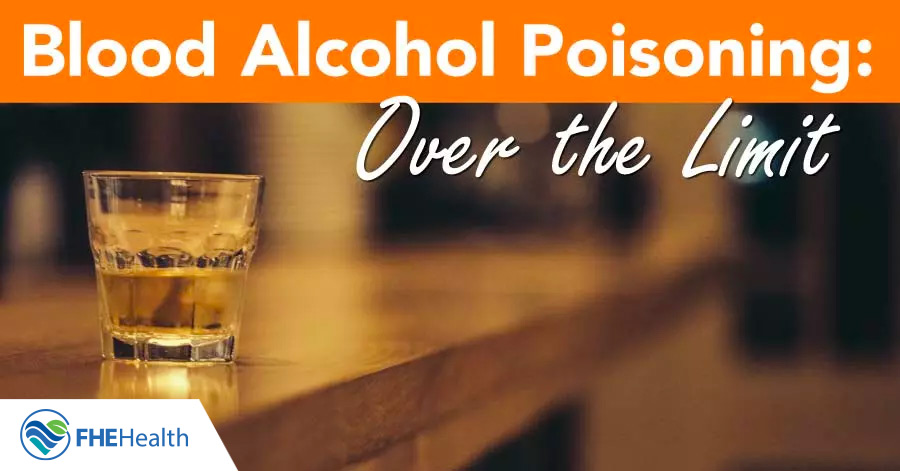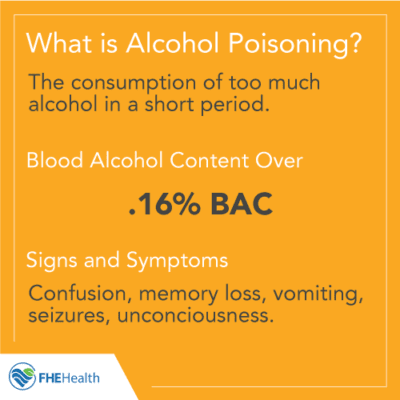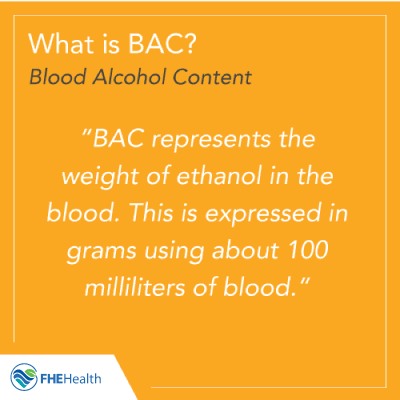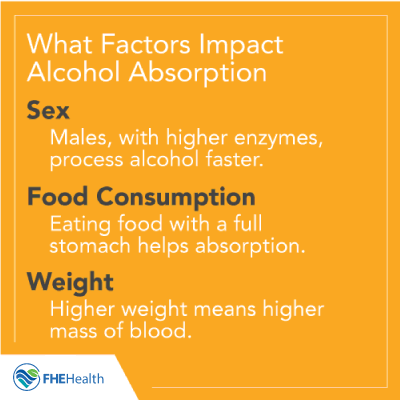
|
|
Updated September 29, 2023
How much alcohol is too much? When it comes to indulging in a drink, moderation is key — but knowing how much that is can be a challenge.
Most people who wouldn’t be classified as alcoholics enjoy alcohol in small amounts. They don’t think about it throughout the day obsessively; instead, they use it to enjoy a buzz or reduce their stress. At the other end of the spectrum are those who drink obsessively all day long and focus much of their attention on the idea of numbing themselves with alcohol.
No matter where you fall on this spectrum, everyone is at risk of alcohol’s dangers. It’s good policy to be aware of the key signs of alcohol poisoning — so be vigilant knowing the BAC levels that lead to alcohol poisoning and the symptoms such as vomiting, irregular breathing or heartbeat, or difficulty maintaining consciousness.
Need Help?
Treatment can begin quickly and discretely, get started now
What are the Dangers of Alcohol Overdose?
 Alcohol is within reach for most people when they desire it. This ease of access makes it very difficult to see the associated risk, but like any other drug, alcohol is only acceptable when it doesn’t cause physical harm to your body or brain.
Alcohol is within reach for most people when they desire it. This ease of access makes it very difficult to see the associated risk, but like any other drug, alcohol is only acceptable when it doesn’t cause physical harm to your body or brain.
Alcohol overdose, or alcohol poisoning, is a high-risk situation for your physical and cognitive well-being. If you believe your loved one is suffering from this, you should seek immediate help.
Drinking too much leads to several immediate problems and health risks. These include:
- A loss of impulse control
- Difficulty making decisions
- Impairments to motor control and coordination
- Reduced inhibitions, leading to reckless behavior
- Difficulty communicating
In addition to these risks, frequent drinking and alcohol overdose can result in many long-term health issues, including:
- Higher risk of stroke
- Increased chance of dementia and other long-term memory loss
- Body tremors
- Developing addictions to other substances
- Increased risks of mental health issues such as depression, eating disorders and anxiety
If you find yourself regularly dealing with these issues, you’re likely drinking too much and over your personal limit. It’s important to reach out to a care provider specializing in addiction or mental health who can focus on addressing the cause and curbing these risks in the future.
Start Treatment Now
Treatment can begin quickly and discretely, get started now
When Does an Alcohol Overdose Occur?
The National Institutes on Alcohol Abuse and Alcoholism draws firm lines between drinking within controlled limits and when alcohol overdose occurs. When a physical overdose occurs, there’s too much alcohol in the bloodstream. The areas of the brain that control life support functions within the body begin to slow and, in some cases, shut down. This includes heart rate, rate of breathing, temperature control and the central nervous system as a whole. An alcohol overdose is a life-threatening situation that requires immediate medical help.
Anyone, even those without an alcohol addiction, can suffer an alcohol overdose at any time. The amount of alcohol causing this depends on various factors. For some, a single shot of alcohol can cause it. For others, it takes a significantly higher amount.
What are the Key Signs of Alcohol Poisoning and What Should You Watch For?
Key signs of alcohol poisoning include:
- Clammy skin
- A slowed or faint heartbeat
- Mental confusion or lack of focus
- Vomiting, sometimes violently
- Difficult breathing or catching one’s breath
- Inability to respond normally to pain, stimuli or vocal commands
- Choking
- Low body temperature
There are some symptoms of alcohol poisoning that can indicate a medical emergency, requiring a call to emergency personnel. These include:
- Seizures
- Mental confusion and stupor
- Inability to remain conscious
- Inability to be awakened
- Low body temperature
- Blue-colored skin
- Irregular breathing
- Irregular heartbeat
Begin your recovery today
Ready to start? More questions about treatment?
What is Blood Alcohol Concentration and What are the Limits When Drinking?
 When does overdose occur, and why do some people have the ability to drink much more than others and stay coherent? It all comes down to blood alcohol concentration, or BAC. This numeric figure represents the amount of alcohol in a person’s bloodstream. Breath alcohol concentration expresses the amount of alcohol present in a person’s breath.
When does overdose occur, and why do some people have the ability to drink much more than others and stay coherent? It all comes down to blood alcohol concentration, or BAC. This numeric figure represents the amount of alcohol in a person’s bloodstream. Breath alcohol concentration expresses the amount of alcohol present in a person’s breath.
Technically, BAC represents the weight of ethanol in the blood. This is expressed in grams using about 100 milliliters of blood. When too much alcohol enters the bloodstream at a rapid rate, it creates an increased risk of overdose because the brain and body can’t handle that amount and begin to shut down. The National Institutes of Health, and most state laws, indicate what alcohol poisoning BAC puts a person at risk. That risk is most prevalent beginning at 0.08% BAC and increases from there.
Typically, this happens in about:
- Four drinks consumed by an average-sized woman
- Five drinks consumed by an average-sized man
A standard drink is equal to 12 ounces of a regular beer, which contains 5% alcohol, or 8 to 9 ounces of a malt liquor, which contains about 7% alcohol. About 5 ounces of wine contains about 12% alcohol, and 1.5 ounces or a shot of spirits such as tequila, vodka or whiskey, which contains about 40% alcohol, also equates to a single standard drink.
How Does the Body Absorb Alcohol?
 The number of drinks you have is a basic indicator of intoxication risk. The more drinks consumed, the higher the BAC is likely to be. However, other factors also impact when a person drinks too much. Specifically, the rate at which the body absorbs and metabolizes alcohol, which differs from one person to another, is a key determining factor.
The number of drinks you have is a basic indicator of intoxication risk. The more drinks consumed, the higher the BAC is likely to be. However, other factors also impact when a person drinks too much. Specifically, the rate at which the body absorbs and metabolizes alcohol, which differs from one person to another, is a key determining factor.
In other words, these factors determine when your BAC level is going to reach that critical 0.08 percentage where risk of alcohol poisoning is high. Among those factors are the following, according to Stanford University.
How Does Your Biological Sex Affect Your BAC Level?
The differing biological makeup of men’s bodies and women’s bodies impacts absorption. As a general rule, male bodies are capable of metabolizing alcohol at a faster rate than female bodies. That’s because women have fewer enzymes to do so than men do. As a result, it takes less alcohol for a woman to reach the 0.08 percentage.
How Does Food Consumption Affect Your BAC Level?
You may have heard that having some food in your stomach can help slow down intoxication, which is true. The digestive system is irritated by alcohol and absorbs the alcohol at a faster rate to remove it. However, when a person consumes food first, this can soften the blow to the digestive system and decrease the chance of alcohol overdose.
How Does Weight Affect Your BAC Level?
A person’s weight can also impact how much it takes to get drunk. For example, someone who weighs 150 pounds has less body mass and blood flowing through their body than someone who’s 250 pounds. That means a 150-pound person needs to consume less alcohol to reach a full intoxication level.
In addition to these factors, others can contribute as well. For example, some medications interact with alcohol, speeding the intoxication impact. Also, many medications taken with alcohol can create additional side effects that can make it even harder to focus. Some interactions are fatal. Drinking at a rapid rate can also impact how quickly it takes to overdose. The consumption of significant amounts of alcohol in a short period of time increases BAC much faster than sipping a drink.
Seeking Help for Alcohol Use
When a person consumes alcohol at a high rate on a frequent basis, there’s a risk that the individual is suffering from alcoholism or an addiction to alcohol use. As a person uses alcohol more and more, the body becomes better able to absorb it, but that doesn’t mean the risk factors for long-term impact don’t occur.
Alcoholism needs treatment. Reach out to FHE Health for support and care in a safe environment, reducing the risk of alcohol overdose or poisoning and starting down the path to a happier life.
More Questions about Treatment?
We offer 100% confidential and individualized treatment
About Ian
Ian is a copywriter at FHE Health, contributing blog and learning center content.






